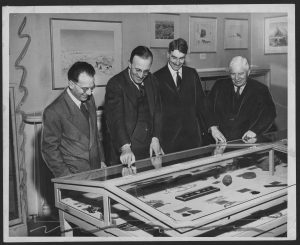Vilhjalmur Stefansson and his Canadian Arctic Expedition (CAE) crew were poised to venture onto the frozen Beaufort Sea in March 1914. Problems, however, abounded. With food running low, his men were on the verge of mutiny. Stefansson was suffering from debilitating hemorrhoids, an affliction he tried to hide lest he lose even more of his crew’s confidence. To top it all off, his navigation equipment was faulty. Then J.J. O’Neill came to the rescue, at least in part. The 27-year-old from Port Colborne, Ontario, had been a vocal critic of Stefansson’s leadership — and he’d joined the CAE as a geologist, not a proctologist — but he was packing a working chronometer.

O’Neill thought the Beaufort Sea mission, basically hopping from ice drift to ice drift, was tantamount to suicide. He didn’t want Stefansson to fail, though, just because he didn’t have proper equipment, so O’Neill volunteered his own precious chronometer. Stefansson and a small party (not including O’Neill) would go on to spend an epic 96 days on the open ice — a major development in Arctic Ocean exploration — before rejoining the rest of the CAE in autumn.
O’Neill’s small gesture not only saved Stefansson’s mission, but was the beginning of his life-long commitment to the Arctic. John Johnston O’Neill earned a BSc in geology and mining from McGill University, and a PhD in structural geology and petrography from Yale. After the CAE, he worked for the Canadian Geological Survey (his assignments including exploring Arctic copper deposits) and, briefly, in India. In 1921, he became assistant professor of geology at McGill, the first of an impressive list of positions he would hold until retiring in 1952: associate professor, head of the Department of Geology, dean of Science, dean of Graduate Studies, dean of Engineering and, finally, vice-principal.
The Arctic, however, was never far from his mind. In 1924, O’Neill published the first geological study of the mainland coast of Arctic Canada. He helped found the Arctic Institute of North America, a multidisciplinary research institute that was based at McGill until moving to the University of Calgary in 1976. And, yes, there was a prolonged, and very public, fallout over that troubled 1914 expedition. Stefansson’s memoir, The Friendly Arctic, incensed many of his former crew. O’Neill took Stefansson to task in the pages of the New York Times, questioning the seaworthiness of a particular schooner (amused locals, he said, took bets on how long the leaky ship would last) and accusing the government of creative accounting to conceal unnecessarily high CAE spending. Still, when the feuding pair found themselves at an Arctic Institute board meeting some 30 years after the expedition, they agreed to work together for the one thing they shared: a passion for advancing knowledge about the Arctic.
J.J. O’Neill died in 1966. His name, if not exactly carved in stone, is remembered in rock: In 1999, researchers discovered a new mineral on Mount Saint-Hilaire, Quebec. They called it “Oneillite.”
